


another image
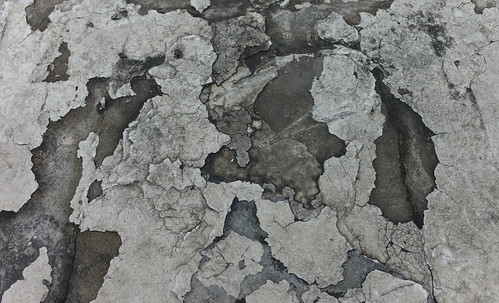
scenario building for Future Preparedness Case Study


In future prehearsals, we aim to model possible futures as participatory performances - scenarios in which we can surprise ourselves and challenge our creative know-how and insight. At FoAM we have been dissecting and experimenting with possible scenarios emerging from the question, “How do we work together on interesting things?”
The models we used for scenario planning and forecasting indicate that it is vital to start with a central issue or working theme that is important to the group or organisation as a whole. Different aspects of this issue can then be explored within a set framework through a number of tools and methods, facilitating the construction of scenarios for possible futures.
As such, the main point of focus within the framework of our Future Preparedness case study for the Resilients project has remained on the organisational framework of FoAM itself. As a result of this exercise, we produced a diagram that charted "uncertainties" along 2 axes, "commitment/availability" and "vision/interest." This produced 4 quadrants:
On this basis we next came up with four distinct models of collaboration that could subsequently be prototyped in experimental scenarios: FoAM as a Bohemian Salon, an Incubator for Successful Individuals, a Weekend Warriors garage band, and a Flotilla.
The next step will be to “prehearse” each of these collaborative models, putting them into practice as experimental situations in the daily life of the studio. We think that these approaches could prove to be relevant and useful beyond their testing at FoAM, to organisations and groups facing similar issues to those we are tackling. In this way, we aim to cultivate beaviours that allow us to be prepared for any possible future.
The main working page for the Future Preparedness case study can be found here: http://lib.fo.am/resilients/future_preparedness
Work-in-progress for each of the scenarios are here:
Sensing Resilience - Workshop
together with Kon-Hyong Kim and Muhammad Hafiz Wan Rosli
7th of May | 3 - 9 PM | Time's Up | Industriezeile 33b | 4020 Linz
Join Kon-Hyong Kim and Muhammad Hafiz Wan Rosli for their introduction and implementation of the SINUNI sensor-system, currently under development by the Arctic Perspective Initiative (API) and the SYSTEMICS lab at the University of California in Santa Barbara.
Please register by sending an e-mail to info@timesup.org - limited number of participants
For more information look: http://timesup.org/sinuni
The workshop will comprise the presentation of the SINUNI architecture and a hands on section, including the implementation of the network and its solutions in the context of the Time’s Up gardening endeavours - in particular the Non-Green-Gardening project by Natalia Borissova.
In 2010 and 2011 API developed and experimentally deployed a robust open hardware sensor network and communication system, the SILAMILU NUNAMULU NIPILIURUTI in short SINUNI.
The SINUNI is an extremely low power, compact, modular and waterproof portable computing and recording family of devices, based on the Arduino architectures, implementing a true mesh networking capability through low power radio and precise geo-location. Its modular sensor architecture records basic meteorological, position and movement data, but it can be outfitted with an array of sensors as diverse as water turbidity, temperature, salinity and p.e. light quality and structure measurements. The open standards used in the software and hardware development ensure that the system can be built, modified and replicated. The units will also enable geo-located audio recording and wildlife observations and note taking through a simple, robust and intuitive interface.
SINUNI is part of the pan-European project RESILIENTS project, developed and implemented with the support of the Culture Programme of the European Union. SINUNI will serve as a sensor device of choice for recording field work data and travels and versions of it can be implemented at fixed locations, for instance to monitor soil and nutrients conditions in the RESILIENT gardens like the Non-Green-Garden at the Time's Up Labs.
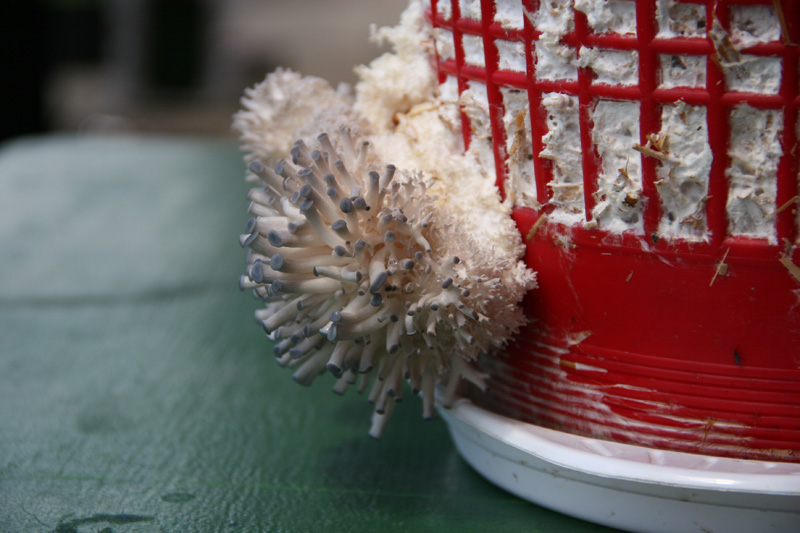
A day of rhizhomic stimulation, the first Non Green Gardening workshop has participants sterilised hands deep in the mixture of spores, mycellium and fodder. We look forward to the emergence of mushrooms in 3-8 weeks.
----------------------------------------------------------------------- title: Subak at Burning Ice Festival, Brussels slug: subak-burning-ice-festival-brussels summary: creation date: 2012-06-06 09:42:11 author: pippa buchanan content:
After travelling for just over a week from the French border through miraculous, sunny Belgian weather (and only one severe rainstorm), Subak and her crew have arrived in Brussels. We’re now camping in residence at FoAM Brussels preparing the Subak and assorted project documentation to appear in the Burning Ice Festival.
Subak will be on display by the canal near Kaai Theatre from the 5th of June through to June 10th. Members of the project will be on hand most days between 17.00 and 19.00 to answer questions about the project.
Popular questions include: Where do you sleep? What’s the solution to water management issues? Why aren’t you using the motor? Come visit us to find out the answers!
Time’s Up will also be discussing their project and their contribution to Crosstalk‘s Bridges Over Troubled Water essay collection from 19.00 on Thursday June 7th at Kaai Studio, Onze-Lieve-Vrouw van Vaakstraat 81, 1000 Brussels
----------------------------------------------------------------------- title: Bid for Subak in our Idea Auction slug: bid-subak-our-idea-auction summary: creation date: 2012-06-06 09:44:20 author: pippa buchanan content:Not only can you visit the Subak at Burning Ice Festival and imagine how it feels to travel down canals and rivers in a boat made of junk – you can also help determine the boat’s future by making a bid for Subak in our Idea Auction.
When we conceived the Control of the Commons project we not only wanted to make the boats out of recycled components we wished to continue their useful lives at the end of the project. Subak2 was bought by a grape grower we met in Renmark and we’re excited to announce that we’ll be handing on the original Subak in an Idea Auction at Burning Ice.
You could be the next owner of Subak by sharing your concept for the boat and its component parts:
Subak and crew members from Time’s Up will be at Burning Ice Festival in Brussels, Belgium.
----------------------------------------------------------------------- title: Future Food and Resilient Architecture slug: scenarioplanning-workshop-foam summary:
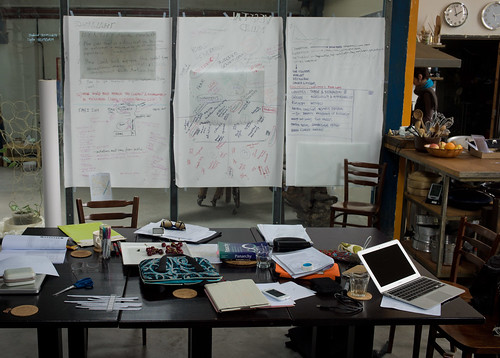
When I rang the noisy doorbell it was just like any other visit to FoAM: I hadn’t a clue what was going to happen once I stepped through the door. Just in case, I brought some Resilients food – diverse, redundant, and distributed sources of nutrients in the shape of seeds – which would surely help us through the coming scenario planning experiment.
We put some tea, coffee, and Swedish chocolate horses on the table. We proceeded to cut out three big paper sheets and stick them to the wall. We were now ready to open the toolbox brought by Anna Maria and David. We would use these tools one after the other to shape potentially desirable futures from a challenging situation in the present.

We narrowed our focus to the exact region of Molenbeek in which the FoAM studio is located: a block delimited by Future and Prosperity streets, with the canal on one side and the Saint Jean-Baptiste square on the other. In a hypothetical 2015, we asked ourselves if community contact and engagement in this area could be improved through food. We were interested in opposing food diversity to waste, curiosity to intolerance, and finally distilled a scenario based on “food diversity and intolerance.”
The narrative took shape. Nights are misty, streets are sludgy, and the atmosphere is heavy. Rats scuttle along the sidewalks, hiding in abandoned TVs and foraging in rotting waste. A system of food clubs has emerged, soaked in crime and corruption. These clubs are very selective, and entering them is almost impossible. You have to painfully demonstrate your devotion to their ideology if you ever want to get in. Scary bodyguards stand outside heavy closed doors. From the street, you can hear loud parties from behind the walls in closed courtyards, and sometimes catch a mouth-watering whiff of rotating roasting chicken. When members of opposing clubs come across one another on the street, the black looks they exchange tell of mutual animosity.
Thanks to the panarchy model detailing the life cycle of complex systems, we saw this scenario as illustrating a situation on the verge of creative destruction. In this view, the overspecialised and un-resilient club system would quickly reach a point of crisis, allowing new dynamics to emerge. We defined three possible futures that might eventuate in this way.
1) The tension reaches a climax and leads to a giant food fight between groups, leaving a huge amount of waste in the streets. The neighbourhood is closed by police, and the food distribution network is blocked. Skywalks are built from building to building. Criminal networks set up and control food flows from the city, while solidarity networks struggle to rebuild the neighbourhood. Waste is slowly transformed in compost, and the streets into gardens.
2) Resource scarcity leads to the reduction of diversity and quality of the food clubs. As affordable food reemerges from the ruins of clubs deprived of their former pride, gentrification occurs and induces drastic changes in the environment.
3) With resource scarcity, the divide between rich and poor just continues to increase. Clubs become more and more selective, expensive and violent. Food is supplied to these groups by helicopters.
From these three scenarios, we finally tried to determine a normative position, or desirable aspects of each of these alternate futures. Clearly, the global knowledge about composting should be enhanced, as it is a key element in the revival of the neighbourhood. Something should also be done with the abandoned TVs…
If I use this toolbox the next time I'm about to ring FoAM's noisy doorbell, it may give me an insight about what will happen when I step inside. Although I don't need any toolbox to know that the journey will be unusual, and quite transformative.
----------------------------------------------------------------------- title: Call for peregrines slug: call-peregrinis summary:From North Poland to Croatia a fold has been discovered on the map of Europe. The Peregrini Cycling Crew will wonder
along this line as closely as possible (in July 2012) with a bicycle-caravan. Each member of the crew will have a
specific focus during the journey.


[EN]
In order to prepare for their 2012 green-powered pilgrimage tour, the Pollinators are gathering for the MAKING AND REMAKING OF SAINTS AND VENERATIVE PLACES workshop on Rab. The workshop includes a public program, and we invite students, cultural workers and the interested public to take part in the open program.
KINETIC CHAPEL NO. 1
During the weeklong workshop, we are building a kinetic chapel – a chapel featuring an animated saint. The chapel will probably be the first of its kind running on solar-energy. The animation is a specially developed stop-motion technique using sequences of film negatives exposed through a large-format pinhole camera.
Anyone interested in taking part in the chapel building workshop is welcome to join in between 10 am and 2 pm during the period of 10-15 September. (Palit, iznad skladišta Rab-komerc). The workshop is held in Croatian and English.
INAUGURATION AND OFFICIAL OPENING OF THE KINETIC CHAPEL
Palit, Thursday 15th of September at 18.00 (iznad skladišta Rab-komerc)
"KAMPOR – a commemorative place" Monday 12th of September 16.00
Ivo Barić, historian, professor and author on several books about the history of Rab, will make a guided tour and lecture on the Italian concentration camp on Rab. The camp was established in July 1942 and it soon became known for its appalling conditions, which caused the deaths of numerous inmates. The tour is held in Croatian with English translation.
FILM SCREENING Kino Rab, Saturday 10th of September 16.00-18.00
What is a map? What is a journey? What is a sacred place? What is a pilgrim?
These are some of the initial questions the Pollinators are asking while preparing their 2012 green-powered bike odyssé through
Europe. In a 2 hour long open film program we seek inspiration in relation to these questions.
The Pollinators workshop is initiated by Performing Pictures, with the kind support of Stockholms Stads Kulturförvaltning, The Swedish Arts Grants Committee and the EU Culture Programme 2007-2013.
----------------------------------------------------------------------- title: Kinetic Chapel slug: kinetic-chapel summary: creation date: 2012-06-25 22:40:30 author: Geska Helena Brečević content:We have built a kinetic chapel on family land on the island of Rab, Croatia. It is as a gesture of reconciliation, personal as well as communal. By doing this we also remember our grandmother Dorica, who learnt us non-conformism; and to appreciate paradox.
In preparing for the Peregrini's bike trip from Koszalin (Poland) to Rab (Croatia) Performing Pictures' are hosting artist
and architect Patrik Qvist.
creation date: 2012-06-26 10:26:31 author: Geska Helena Brečević content:

Patrik is preparing a cast for a road altar shrine with Saint Christopher to be cast in concrete along the road and left as a memorial and venerative artifact.
I've got a bike
You can ride it if you like
It's got a basket
A bell that rings
And things to make it look good
I'd give it to you if I could
But I borrowed it
Bike Song by Pink Floyd
----------------------------------------------------------------------- title: Dougald Hine, journeyer slug: dougald-journeyer summary:A Resilients journeyer is a part of a larger support structure we envisage for those who see the arts as a place to prototype social change or cultural revitalisation. At the moment, there are six organisations and several dozens of practitioners involved in the project, as apprentices, journeyers or masters. In the medium term, we're interested in forming a distributed Guild of Resilients, able to provide opportunities for personal and professional development, technical and conceptual infrastructure for research and creation, as well as food and shelter for Resilients in transience.
creation date: 2012-07-03 22:40:30 author: Maja Kuzmanovic content:We invited Dougald to be our first 'artist in transience', adapting the role of a traditional guild journeyman to today's creative practices. What inspired us in the journeyman's role is the movement and sharing of knowledge, making connections between people and places, as well as itinerant, practice-based learning. Travel and exchange enrich both the journeyers and the people they visit. What differentiates this role from that within a traditional guild is that we see the sources of the knowledge being open rather than kept secret within the walls of guildhall and that today's journeyers should be able to travel across boundaries of disciplines, cultures and genders as well.
A Resilients journeyer is a part of a larger support structure we envisage for those who see the arts as a place to prototype social change or cultural revitalisation. At the moment, there are six organisations and several dozens of practitioners involved in the project, as apprentices, journeyers or masters. In the medium term, we're interested in forming a distributed Guild of Resilients, able to provide opportunities for personal and professional development, technical and conceptual infrastructure for research and creation, as well as food and shelter for Resilients in transience.
We wanted to test these ideas in practice, with someone who is aware of the cultural and social challenges we're experiencing today, as well as being able to extract meaningful lessons from the past. We were looking for someone comfortable with being a part of an experiment that does not have a predefined route or methodology. The Resilients journeyer should be curious, adaptable and eager to connect people and ideas on the fly. Dougald seems to be the perfect candidate.
We asked him to go native and become a Resilients journeyer for a time. His task on the road is to seek out, learn about, collect and connect examples of cultural resilience, historical guilds and guild-like structures of today. It's up to Dougald himself to decide where he goes, with whom he meets and what he does. During this journey he'll share his reflections on what it could mean to be a Resilients journeyer - for himself, for the people who host him, as well as society and culture at large.
Dougald, we wish you wonderful travels and look forward to your stories!
----------------------------------------------------------------------- title: Unmanned Resilience (UR) - Call for particpants slug: call-unmanned-resilience-ur-workshop-participants-and-apprenticeship summary:The Unmanned Resilience (UR) workshop and apprenticeship will be devoted to the art of sensing, remote sensing and understanding of the specific natural and social environment of a mixed agricultural and protected natural environment that is situated in the western part of Slovenia in the vicinity of major urban centers (Ljubljana 50km, Trieste 50km).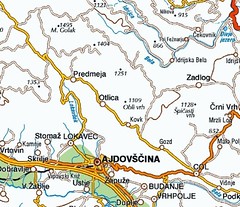
More Info on the Call for participants:
The Unmanned Resilience (UR) workshop and apprenticeship will be devoted to the art of sensing, remote sensing and understanding of the specific natural and social environment of a mixed agricultural and protected natural environment that is situated in the western part of Slovenia in the vicinity of major urban centers (Ljubljana 50km, Trieste 50km).
The four major components of the UR events are:
BE STRONG, BE WRONG! Wild food foraging, classification and sustainable practices
Gigapixel photography for vegetation and environmental classification
Remote sensing in the IR and visible ranges using unmanned aircraft systems
Testing of the SINUNI (Land and climate recording device) sensor network and node devices for gathering environmental, socio-cultural, oral history and econometric data.
There are 8 open slots in for the workshops and apprenticeships.
There are three work phases.
PHASE 1 BE STRONG, BE WRONG! Foraging and data gathering fieldwork
AUGUST 16-20 (day 1 preparation, days 2,3,4) expedition, day 5 wrap up and start of PHASE 2
PHASE 2 UNMANNED REMOTE SENSING operations
AUGUST 20-23 (day 1 preparation, lectures, days 2, 3, 4) operations
PHASE 3 UR APRENTICESHIP and DATA DISPLAY WORKSHOP
AUGUST 24-26 (day 1 theory, day 2 practice, day 3 wrap up)
PHASE 1
BE STRONG BE WRONG! Foraging and data gathering fieldwork
Wild Food Hike from Gora Plateau across Trnovski gozd Woods to Upper Idrija River Wilderness and Back (But Not Straight) Again. So, where do we come from and where are we headed to? As long as we do not care where we are, we cannot really be lost.
But other dangers await us: What? When? How? Where?
What?
A four day hike though the woods, over the mountain (or at least hill-) tops, through semi-civilised but also quite wild landscape, passing some really friendly homesteads, staying in deep forest darkness, waking up straight into the sun, doing this, doing that ... (not much, really). But basically just trying to link our own selves to what we already know but pretend we forgot it.
|
When? August 17th to August 20th, 2012. |
How much? About 8 hours walking time a day. |
How many? Up to 8 participants. |
|
Where will we eat? Along the way. |
What will we eat? That's the question. |
Will we be hungry? No. Or maybe yes. |
|
Will we be thirsty? Very likely so. |
What to bring with? Mattress, sleeping bag, raincoat, reliable hiking shoes, suitable clothes (mid-August might be a bit refreshing in these woods in the early morning hours), knife, spoon, small bowl. |
The aim Who knows? We'll get to know it. Probably the most important aim is to cultivate the hunger, which leads us here and there, everywhere. To wide open spaces and beyond. |
Please do not forget creative hunger, but please do leave appetite behind.
DISCLAIMER
Sorry, this is no survival camp.
We'll take advantages of both worlds, the wild one and not so wild one.
But we will definitely be moving through wilderness and will collect quite a few wild edibles, from plant and fungi kingdoms predominantly. Just as a matter of fact we'll be facing, at least theoretically, a vast expanse of over 3000 wild plants and about the same number of fungi, which grow just by themselves, all wild, here in Slovenia. That means, we'll collect at least 3 plant species and probably not more than the same number of fungi and will devour them all, bones and skins included.
During these days, we will have a radio and phone link to the wider world, we will be bumping into local biological and less farmers and talking to them and getting some food from them, we will be probably meeting hunters and hikers and we will even take a bath or two in the rivers nearby. The organizers will take care of first aid and vehicular assistance when needed. We will never be far from civilization at all, but it will many times feel so.
We will document everything we will eat, do gigapixel resolution imagery of the areas where we will stop, forage and eat, record our paths, record our stories and the stories of the people we will meet and display everything by using an online open source mapping environment developed by our colleagues in Slovenia called GEOPEDIA.
Some of the places we will see during the expedition.
Once every day, we will request aerial imagery of a specific area to be taken by the Unmanned team of C-ASTRAL and we will receive an imaging product the next morning via wireless data links. The expedition will at the end bring us to the "main" base on the mountain top of Sinji Vrh (the Azure top).
On the 20th we will have our first large data collection and organization workshop and will prepare for the next few days of unmanned aircraft systems remote sensing operations throughout the plateau.
All of the data in the field will be recorded using the SINUNI mobile nodes. SINUNI is a project that started as part of the Arctic Perspective Initiative.
The Arctic Perspective Initiative (API) is a non-profit, international group of individuals and organizations whose goal is to promote the creation of open authoring, communications and dissemination infrastructures for the circumpolar region. Its establishment is the direct result of the work of the IPY project 417. The aim of API is to work with, learn from, and empower the North and Arctic Peoples through open source technologies and applied education and training. By creating access to these technologies while promoting the creation of shared communications and data networks without costly overheads, continued and sustainable development of autonomous culture, traditional knowledge, science, technology and education opportunities for peoples in the North and Arctic regions is enabled.
In 2010 and 2011 API developed and for the first time experimentally deployed a robust open hardware sensor network and communication system, the ᐅᓂᓗᖑᒪᓂᓗᒥ ᓴᒥᓴᖑᒪᒥᓗᒥ ᓴᓂᔨᓂᓗᓂᒥᑭᒥᑎᓂ (SILAMILU NUNAMULU NIPILIURUTI) or SINUNI. The SINUNI is an extremely low power, compact, modular and waterproof portable computing and recording family of devices, currently based on the Arduino architectures implementing a true mesh networking capability through low power radio and precise geo-location. It's modular sensor architecture records basic meteorological, position and movement data, but it can be outfitted with an array of sensors as diverse as water turbidity, temperature, salinity and p.e. light quality and structure measurements. The open standards used in the software and hardware development ensure that the system can be built, modified and. The units also enable geo-located audio recording and wildlife observations and note taking through a simple, robust and intuitive interface. During the fieldwork in the Foxe Basin and the Fury and Hecla straits in the Arctic (January and August 2011) large amount of environmental, wildlife observation and traditional place-names and trail data was collected. The system enables instant review of the collection in the field, but more importantly, its mesh architecture enables a seamless transfer of data and network bridging between the different units without any specific inputs from the users, leaving them free to concentrate on the work on the Land. The geo-locative approach to all data and sound recording gathering facilitates the creation of quick reference maps with audio annotations and the entry of the data in GIS systems.
In the framework of UR, the SINUNI will be used to collect environmental data, record interviews and discussions and geolocated data. This data will be then displayed, for the purpose of UR, using the GEOPDIA platform.
PHASE 2
UNMANNED REMOTE SENSING OPERATIONS
The second phase of the UR is geared towards the collection of remote sensing data using state of the art unmanned systems under the guidance of the C-ASTRAL AEROSPACE team. Each day will start very early, with a meeting defining a daily tasking order, choosing of sensors and planning. Flying operations will happen from around 10.30 am to 2pm, the afternoon and evening will be devoted to the evaluation of the gathered data, lectures and the uploading of the imagery to the online platform.
The C-ASTRAL UAS family consists of two lines, the BRAMOR gEO line and the EO line.
The BRAMOR gEO line is specialised for the creation of cartographic datasets that can be used in Geographic Information Systems of any kind including:
Damage assessment
Natural disaster damage assessment
Change detection
Illegal dumping and spills detection
Vegetation and crop classification
The BRAMOR gEO flight path precision and software capabilities are extremely high, and 1 centimetre level ground sampling distance (GSD) products are achievable with the system.
BRAMOR gE0-2012 SYSTEM CHARACTERISTICS
Aircraft type: fixed wing, blended wing body configuration
Airframe: kevlar reinforced carbon composite airframe
Avionics: Lockheed Martin and C-ASTRAL ORTHOboard
Airframe colour: RAL 2005 LUMINOUS ORANGE or SKY GREY
Propulsion: brushless electric
Heated pitot
LED navigation lights
Strobe beacon.
Operative payload endurance: 90-120min depending on range requirements and flight profile
Operating launch temperature for pneumatic catapult: -30deg C to + 85deg C in NON ICING CONDITIONS
Sensors operating temperature: 0deg C to 50deg C (sensor heating unit is an option for operations in
sub 0 deg C conditions)
Sensor: digital, 25mega pixels CCD with CARL ZEISS or SIGMA 24mm, f1.8 or f2.4 optics
Infrared and multispectral sensors in different wavelengths are an option and can be supplied and integrated in the system.
Flight into KNOWN ICING CONDITIONS (IFR) IS NOT PERMITTED.
Landing system: parachute or classical landing
Launching system: pneumatic catapult CAT2 or elastic catapult CAT1 (depending on mission profile and
Maximum operational windspeed: 11 m/s
Maximum windspeed at t/o: 5.5 m/s
Command and control frequency: 868 MHz
4 LI-PO battery packages
Rugged all wather transporation cases for all systems components.
Different software packages will be used to work on the remote sensing data and the apprentices will learn the basics of the processing and orthorectification, data annotation, together with the basics of preparing the data for online publication on different platforms.
During phase II, The flights will be conducted by the C-ASTRAL team and apprentices will be assisting and learning in the field. Phase III will be devoted to apprentices actual hands on training.
PHASE 3
UNMANNED RESILIENCE APRENTICESHIP and DATA DISPLAY WORKSHOP
Iglulik, Nunavut, instant orthophoto BRAMOR UAS
From August 23 to August 26 the apprentices will be learning the basics of flight and remote sensing, they will go through the thorough training for the BRAMOR UAS systems, which will include a day and a half of classroom theory, solo flights and half a day of learning how to safely fold a parachute.
The last two days will be devoted to working sessions that will place and annotate all Unmanned Resilience data on the web platform and to the creation of the project final website.
Example of a 3D terrain image created with the BRAMOR UAS
The Unmanned Resilience "base" will be on the Sinji Vrh tourist farm, which has one of the best locations for all kinds of environmental and radio work in that part of Europe. Besides the remote sensing operations, Projekt Atol experts and the resident artist, Matthew Biederman aka DelRay will set up radio and satellite listening workstations and small ad-hoc side tactical media workshops will take place throughout the week of August 20.
IMPORTANT INFORMATION
Coordination contact: Uros Veber office.atol@gmail.com
Content contact and apprenticeship questions: Marko Peljhan mp@arcticperspective.org
Chief tutor at C-ASTRAL: Samo Stopar samo.stopar@c-astral.com
Chief tutor for Geopedia: Grega Milcinski grega.milcinski@sinergise.com
It is highly advisable that all participants bring hiking equipment and a backpack with basic hiking gear and clothing, sun screen, and personal hygiene items and of course your gadgets and computers.
It is also advisable that all participants carry travel insurance.
The UR team will provide food, lodging, transportation around Slovenia and to and from the airports and train stations, com
Please advise Uros of special dietary concerns and allergies.
----------------------------------------------------------------------- title: Peregrini - travelling in resilient mode slug: peregrini-travelling-resilient-mode summary:
The Peregrini keep us updated about their adventures at http://performingpictures.se/node/127 and http://www.various-artists.be
creation date: 2012-07-11 18:41:07 author: shelbatra jashari content:
We are the Peregrini Cycling Crew, we follow a fold on our map and go straight from the North Sea to the Mediterranean, from Poland to Croatia, through lands, forests, villages, mountains, fields and cities. We are by bike and we are solar powered. We bring stories and creations. When you meet us or see a trace from us it means you are part of that fold, and one of it's inhabitants.
Performing Pictures' Robert Brečević will place 13 road chapels along the fold/line. The travellors saint: St. Christopher will be illuminated by night wit a LED-light - powered with a small solar panel.
Less than two weeks after they started their trip in Poland, the Peregrini keep posting images of inspiring moments and landscapes encountered through their trip in Europe.
http://performingpictures.se/node/123
http://performingpictures.se/node/124
http://performingpictures.se/node/125
http://performingpictures.se/node/126
http://performingpictures.se/node/128
http://performingpictures.se/node/129
http://www.various-artists.be/
----------------------------------------------------------------------- title: Unmanned Resillience Call for participants 16-26 Aug 2012 slug: UR-workshop-call summary:
The Unmanned Resilience (UR) workshop and apprenticeship will be devoted to the art of sensing, remote sensing and
understanding of the specific natural and social environment of a mixed agricultural and protected natural environment
that is situated in the western part of Slovenia in the vicinity of major urban centers (Ljubljana 50km, Trieste 50km).
creation date: 2012-07-16 17:48:09 author: Uros Veber content:
The Unmanned Resilience (UR) workshop and apprenticeship will be devoted to the art of sensing, remote sensing and understanding of the specific natural and social environment of a mixed agricultural and protected natural environment that is situated in the western part of Slovenia in the vicinity of major urban centers (Ljubljana 50km, Trieste 50km).
The four major components of the UR events are:
1. BE STRONG, BE WRONG! Wild food foraging, classification and sustainable practices
2. Gigapixel photography for vegetation and environmental classification
3. Remote sensing in the IR and visible ranges using unmanned aircraft systems
4. Testing of the SINUNI (Land and climate recording device) sensor network and node devices for gathering environmental, socio-cultural, oral history and econometric data.
There are 8 open slots in for the workshops and apprenticeships.
There are three work phases.
AUGUST 16-20 (day 1 preparation, days 2,3,4) expedition, day 5 wrap up and start of PHASE 2
AUGUST 20-23 (day 1 preparation, lectures, days 2, 3, 4) operations
AUGUST 24-26 (day 1 theory, day 2 practice, day 3 wrap up)

The Peregrini keep moving at bicycle speed across Europe, in curageous mode, paying tribute to nature and the universe on their bikes.

During their second week the Peregrini lead us to locations from forgotten times... In almost illusionary mode, they lead us through the various obstacles encountered on their way.
Read the details of their fragile quest here:
and also here: http://www.various-artists.be/
----------------------------------------------------------------------- title: a week of wandering across Southern Europe's lost and forgotten roads slug: peregrini-last-week-wandering-across-europes-lost-and-forgotten-roads summary:

The Peregrini produced quite an effort in getting a more than 1000 km journey on bike in 3 weeks time from Poland to Croatia. Their trip provides for images and thoughts for a different path, away from traditional and established forms of travel.
creation date: 2012-07-22 17:02:38 author: shelbatra jashari content:

After a well merited rest in the Czech countryside, the group gets on the bikes again and continues to roam the line. The road is long and difficult, taking them along ups and downs in the Central and Southern European landscape full of saints and renegades. Solar chapels keep them company along this trip. Keep following this unique journey here:
http://performingpictures.se/node/137
http://performingpictures.se/node/138
http://performingpictures.se/node/139
http://performingpictures.se/node/140
http://performingpictures.se/node/141
http://performingpictures.se/node/142
http://performingpictures.se/node/143
http://www.various-artists.be/
----------------------------------------------------------------------- title: Peregrini - invitation to our pedal-powered travelogue slug: peregrini-invitation-our-pedal-powered-travelogue summary: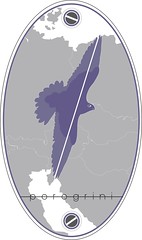
PEREGRINI PEDAL-POWERED TRAVELOGUE
Peregrini’s share their travel impressions : OLD STAIRWAYS IN VAROŠ, RAB OLD CITY 24/07 AT 21.00
creation date: 2012-07-22 17:39:46 author: shelbatra jashari content: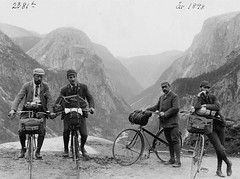
The Peregrini Cycling Crew are a group of artistcollectors traveling by bike along a straight line from Koszalin, Poland to Rab, Croatia in July 2012. The line is a rule, a limitation, it defines the territory the Peregrini can use in their journey, not going from one point of interest to another but exploring and documenting the in-between. The journey is a mobile studio; a mode of creative low power travel. Peregrini explore cultural pluralism and socioregional diversity by traveling, leaving a trace of impressions. The Peregini will be collecting experiences and celebrate forgotten modes of intentional travel. Wandering towards meaningful coincidences leaving traces to mark our journey. For the Peregrini the travel is as important as reaching the goal. They engage with people they meet on the road, capturing their stories, drawing on the disciplines of visual anthropology and storytelling. A series of proof-of-concepts will be produced along the fold to empower cultural practices. By choosing Croatia as a final destination, the journey is also a welcoming act by the Europeanartists in the Peregrini crew. The final destination, Rab city, holds the saint of travellers, Sveti Kristofer, as a patron saint - making it a very suitable point of arrival. During preparations for the bike trip on Rab in September 2011, a site specific kinetic solar chapel was built in honour of Sveti Kristofer, featuring a stop motion film installation.
You can follow the trip and read more on http://performingpictures.se/node/127
----------------------------------------------------------------------- title: Peregrini - Being on the Fold slug: being-fold summary:Peregrini expedition diary on nadine.be

Follow the Peregrini on their 22 days of cycling from Poland to Croatia.
Day 1: Mon 2/7
Leaving from Brussels early in the morning. In Schiphol we change to Berlin, a very cosy train where we'll spend 6 hours in the restaurant wagon. Theun get's in at Hilversum, and there we are: Brussels and Amsterdam Peregrini on the move! In Berlin we change to Angermunde and from there it goes to Szscezin, the unpronounceable city in Poland where we buy our bikes in the morning.
----------------------------------------------------------------------- title: iApps workshop slug: iapps-workshop summary:From 17 to 23 October nadine organizes a workshop iApp building for artists where the participants learn to develop mobile applications on iOS platform.

The focus will lie on the creative and artistic use of mobile applications. The first two days Yannick Berthier will give a basic workshop on programming applications.The following days the artistic possibilities will be explored together with artist Robert Brecevic from Performing Pictures and participants will get to make their own applications. The workshop will take place at PAF, St Erme, France http://www.pa-f.net/. To enroll, please send a motivated email to loes@nadine.be. This workshop is part of the project Resilients and the workshop partnership Splinterfields.
----------------------------------------------------------------------- title: Unmanned RT phase 01 - Notes from the Wild. slug: Zapiski_iz_Divjine summary: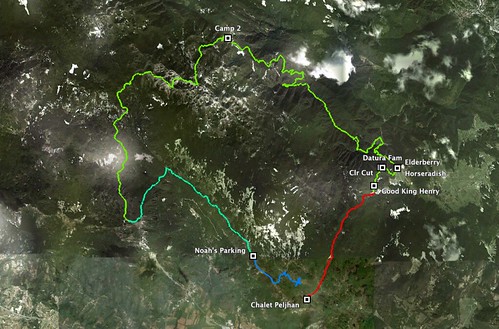
Through the sweltering heat, over the mountain tops and throught the forgotten valleys a team of Hikers moves along powered only by aromatic herbs and the thrill of exploration, to touch,taste and smell the landscape we will be seeing from Unmanned Vehicles, if we make it through this hike...
creation date: 2012-08-25 07:59:32 author: Theun Karelse content:
The Sun is scorching the Slovenian landscape around Marko Peljhan's idilic mountain retreat into a crispy herbal wafer. These hills are experiencing the worst drought for decades. Along the roads plants are covered by a thick layer of grey dust. There is a big cloud of dust behind the landrover that is transporting some of the Resilients. This is a potato safari. The potato field owned by the grandfather of our amazing cook Micha is clearly impacted by the weather. This will be our last supper before the hike. One last night in a tent.
In the morning before the Sun does it's worst, a gentle, rather tall figure appears from the woods. Our guide for the hike Dario Cortese energizes the Resilients team with some Kombucha and Absinth drinks. We proceed into the forest, up to the edge of the cliffs stopping in the most unexpected places to admire local wild edible plants. Dario is a walking encyclopedia sharing a deep knowledge of the countryside with a mixture of English, Slovenian and Latin botanic language occasionally intertwined with historic perspectives by Marko. What an excellent way to become familiar with a new place!
The first day of the Hike leads us into a spectacular national park. Guided by Dario and his intoxicating 'stomach medicines' we proceed deeper and deeper into the forest. By nightfall we find ourselves by a ruined loggers house having a light dinner with potent aromatic herbs that have been charged and condensed by months of blistering sunshine. Sleeping-bags are prepared in the last rays of light. The sunset is amazing, the stars even more so. As we float on a few centimeters of foam in our hiking mattresses, high above us the International Space Station passes, as the nebulous Milky-way reveals itself in all it's glory.
In the dark of night from the hills surrounding our base-camp an awful cry breaks our light sleep. Moving through the woods something is galloping with awesome power. The creature announces itself barking away like a mad dog. Our brave Resilients lie frozen in their sleeping-bags. Why don't these bags have legs so we could run?! Zipped up to our chins, will we be helplessly dragged away into the forest like a conveniently wrapped evening snack?! What is this abomination? To our great relief the beast continues it's journey along the hills to our left to disappear into the night.
The next morning coffee serves as a portal back to reality. In the morning light things seem so much calmer again. The creature that roamed through the night is apparently a male dear! Dario is very amused by our stories from the midnight encounter. We set off relentlessly going further into the wild. This second day of the hike leads us up to dizzying heights into the mountains. The meadows dominated by Wild Carrot and Parsnip have given way to Beech forests with Raspberry that energize empty stomachs and a mountaintop with a telecommunications mast harboring Atropa Bella Donna at its base. Deep under these dry mountains a lake of water resides, the limestone rocks cover narrow tunnels going down in to the deep. The team however continues to climb up until a meadow is reached where we will spend the night. Under the Pine-trees we spend our second night after a meal of ever more potent aromatic herbs.
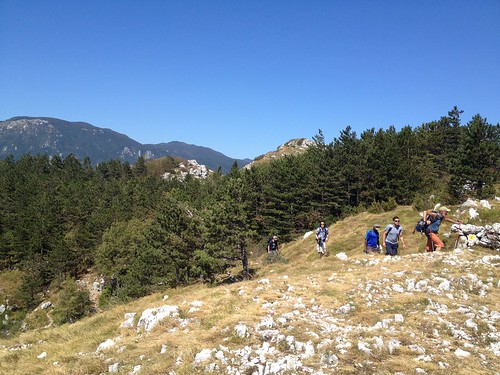
Dario leading the climb, image by Shelly.
The Resilients team wakes up by the sound of what must be a weird local hunter singing like a madman. It turns out however to be our guide Dario. Not all of the team appear to be in great shape. The Absinth 'stomach medicine' has taken it's toll on our Tanzanian fellow explorer. By 'calling some deers' as it is know locally, he clears his body of the spirits that haunt his bowels. The energy however is drained from his body, but he will continue with us up to the very mountain tops. The hike is turning into quite an epic endeavor. Placing feet, grabbing rocks and winding up the narrow paths we climb to the highest ridges. The landscape is unbelievable, like a scene from Lord of the Rings. From the peaks the Resilients oversee their entire journey; from the meadows close to the ridge, to the forgotten valley where we swam in the crystal clear waters. But our stomachs do not let us rest. Rumors have spread of a mountain hut with food down the other side of Viper Mountain. The famished team feasts on strudel and beer. We continue down past the raspberry fields in the forest to make our camp for the night as we re-enter civilization at Caven.
Dario our eccentric but excellent guide has lead us through the hike. We have seen, touched, smelled and tasted this area now. We have learned to recognize many of its plants. We are now ready to continue. We are ready for phase 02 of the Unmanned Rt.
Wild Food's Wide Perspectives, Dario's handout accompanying the hike.
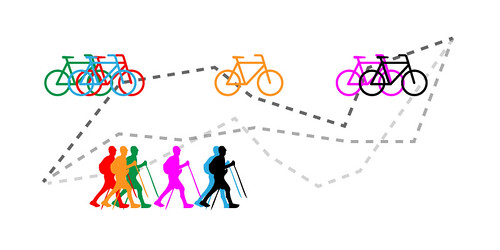
This summer the Resilients have been exploring the European continent in various ways in various areas. Some of these expeditions have been undertaken by groups; the Peregrini / Pollinator bikers through Central Europe and the Unmanned Resilience hikers through Slovenia. What can be learned by overlaying the two experiences? I propose the use of UAV-mission-planning vocabulary for this analysis and for designing future resilient modes of travel.
creation date: 2012-08-28 11:58:04 author: Theun Karelse content:
This summer the Resilients have been exploring the European continent in various ways in various areas. Some of these expeditions have been undertaken by groups; the Peregrini / Pollinator bikers through Central Europe and the Unmanned Resilience hikers through Slovenia. What can be learned by overlaying the two experiences? I propose the use of UAV-mission-planning vocabulary for this analysis and for designing future resilient modes of travel.
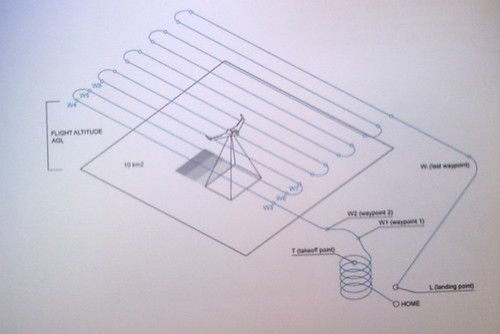
Generally comparing biking and hiking:
The strain on the body, the amount of food and supplies needed were quite similar for both journeys. The experience of the landscape is somewhat more intimate on foot, but more can be explored on bike. Basically you always have sore legs, but on the bike your ass hurts too. Depending on the area cyclists are more flexible in finding food sources, supplies and shelter due to their wider radius of operation. Also heat is less of a factor for cyclists.
Preparation:
Try and stay lightweight. As a participant in both expeditions generally the preparations were very similar; bring essential clothing only, but for a range of weather conditions, very basic utensils (cup, knife, spoon,ear-plugs,sun-cream), tent and sleeping gear. Obviously shoes are less important on bikes, but cyclists need some tools for repairs.
Navigation:
During both missions navigation played a very prominent role. A daily mission would be planned setting a take-off-point and often several options for rally-points and loiters (for lunches, swimming, final destination, etc). In both cases setting a daily route would fall back to only a couple of individuals in the group. This turns out in both cases to greatly impact group-resilience. (See Fail-Safes below.) For the Peregrini bikers a trail had to be planned along the fold using place-names as crude waypoints. The Slovenian hikers would follow existing marked paths as waypoints, which were much more frequent which greatly reduces errors. Group travel includes many instances of loitering, more so for the cyclists, because at many cross-roads the group needed re-navigating and because of the many available places for taking food supplies (village-shops). For the hiking group loitering only occurred at points where existing markings failed of for taking food supplies (Dario's wild food finds).
Group structure:
It's quite clear that traveling as a single group is easier on foot than on cycles where differences in speed are increased by the introduction of gears. Traveling in mountainous terrain these differences become expressed even more, both on foot and bike. This can reduce the resilience of the group when some travelers fall behind; those who struggle can be found in the back. In case of any additional misfortune this can result in a lack of support.
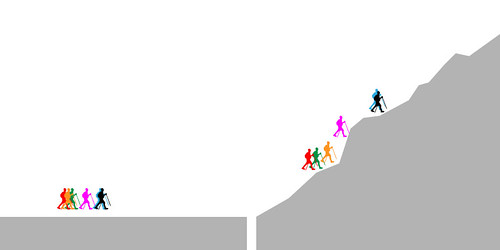
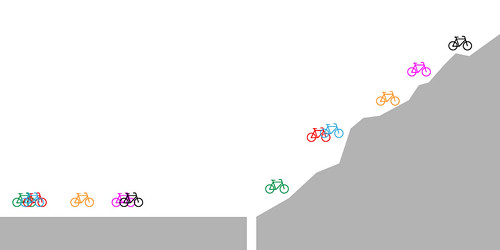
Fail-Safes:
Carrying capacity:
In the case of the cycling group along the fold everything was carried by the travelers and only redistribution of materials was an option. For group on foot a jeep was in place as a fail-safe which could carry some equipment.
Navigation:
The hikers relied on a marked trail and familiarity with the area, but the cyclists relied on GPS-apps, maps, place names and mobile phones as fail-safes for navigation errors. The level of failure was a prominent frustration to the process of reaching the rally-points along the fold.
Accidents and break-downs:
In both groups keeping track of those traveling at the back of the group was an issue. Unfortunately accidents have happened where little back-up was available and mobile-phone connections failed. From the tough lessons learned along the fold by the cyclists, the hikers in Slovenia integrated a fail-safe by keeping a small group at the end, especially when a traveller was struggling or even ill. Also the jeep served as a back-up but due to the success of our fail-safe this wasn't needed.
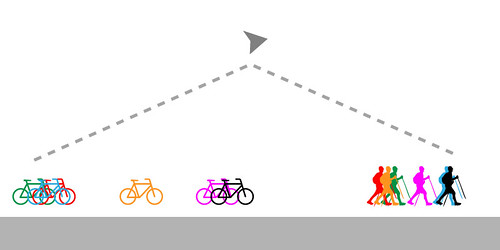
For resilient travel a fail-safe system could be: detailed info for the trail including editable take-off-point, way-points, loiters and rally-points distributed by an independent mode of communication (mesh-network) accessible to all group members, perhaps even enabled by a convoi-ing UAV.
----------------------------------------------------------------------- title: Tasty Resilience slug: tasty-resilience summary: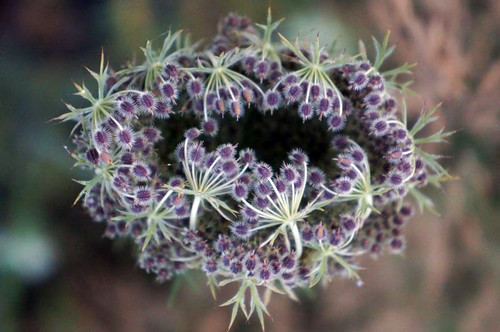
From 15 to 24.8.12 I've found myself among the unmanned and resilient, human- and non-human sensors for testing and tasting the natural and social environment at the western part of Slovenia -- mmm.. that was yummy, even during the hike-days when 'My strudel has been burned already..' became the cry of the day. Look what we've found on the way as an alternative energy sources (well-well, at the beginning.. as a supplements to something more 'real';)
creation date: 2012-08-30 20:43:22 author: Theun Karelse content:
Wild Carrot, image by Natalia
From 15 to 24.8.12 I've found myself among the unmanned and resilient, human- and non-human sensors for testing and tasting the natural and social environment at the western part of Slovenia -- mmm.. that was yummy, even during the hike-days when 'My strudel has been burned already..' became the cry of the day. Look what we've found on the way as an alternative energy sources (well-well, at the beginning.. as a supplements to something more 'real';)
See Natalia's very comprehensive summary of many plants encountered during the Unmanned RT hike on her site here.
----------------------------------------------------------------------- title: Unmanned mission to the realms of Mountain Goats slug: mountain-goats summary:
The Unmanned RT and C-Astral team set out on the hunt for Wild Goats and Raspberry.
creation date: 2012-09-11 12:17:55 author: Theun Karelse content:
View from the launch point for the mission, image by Shelly.
After days of arduous hiking through the valleys and over the mountain ridges of the Slovenian plateau, the Unmanned RT team has safely arrived at Sinji Vrh base camp. The famished travelers are treated to a wonderful meal of Wild Mountain Goat prepared by our host Hieronim and his family.
Now the next stage of the Unmanned Resilience workshop can start in earnest; the Unmanned Remote Sensing. The team-members now intimately familiar with the landscape, are invited to suggest possible missions with the Bramor UAV. Quite a varied cluster of ideas emerge, including:
In the end it's our culinary experiences with the landscape that help to make a choice: the Bramor will be programmed for a dual-mission to discover the fields of forest Raspberries we've encountered and to explore the realms of the mysterious Slovenian Wild Mountain Goats. The stomach is our compass.
A trail of cars leaves base camp heading for the area we crossed on the last day of the hike. This leads us to the slopes of the last mountain from which we descended to the edge of the plateau. In the forest on the mountain are the fields of Raspberries we feasted on and the ragged stone cliffs at the base off the mountain are the territory only the elusive goats can travel.
The C-Astral team prepare the Bramor catapult and it elegantly launches the UAV device that quickly disappears from view. It will now travel where we cannot. It will be our eyes exploring inhospitable places and forests baking away in the summer sun. We can only wait; catching a glimpse now and then of its outline against the sky or a hint of its engine snoring.
In the valley below an airplane takes off. This is bad news. Will it enter the flight path of our mission? Marco and Samo decide the Raspberry stage of our mission has to be dropped. The Bramor will be flying out-off our line of sight. For safety we have to cancel the flight over the mountain forest. The UAV is brought back and parachutes-in safely on the meadow.
The team returns back at base camp. Here the analysis of the images captured during the flight can be started. Will we spot the Mountain Goat in it's natural environment? Each team member gets a selection of images and quickly engages the digital hunt. What excellent resolution! This gives a whole new perspective on the area. Individual trees can be spotted, shadows cast by rocks, or is it a goat! The search gets ever more intense, eyes look over images with feverish haste. Is it a goat we see? Was that shape in the original image or was it photoshopped in by a mischievous team-member? The details remain inconclusive, but at least one group is found, resting on the slopes of the mountain. It is us. It's the team waiting for the Bramor to return, found in image P1010694 in the top left corner. At least we spotted some wild mammals..
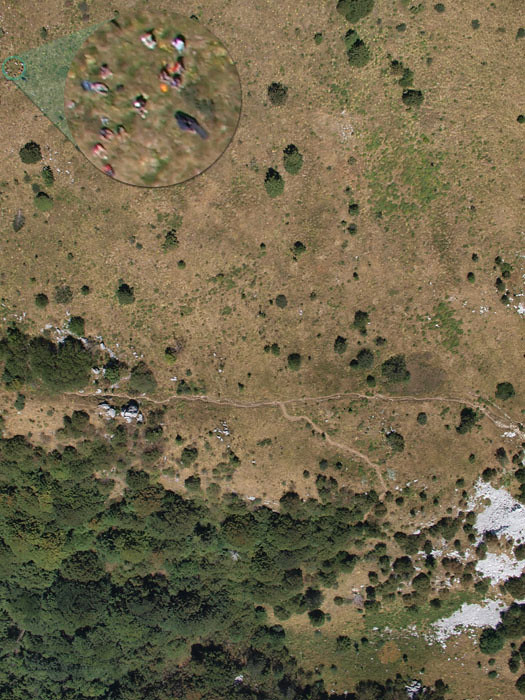
creation date: 2012-09-25 12:51:58 author: Monique Alvarez content:
In 2011 we made an open call for finding interesting concepts for our Augmented Urban Garden. It was Natalia Borissovas Non-Green-Gardening project which was the most appealing one. Within the last months she was regularly onsite - developing and improving her concept of a Non-Green Garden at the Time's Up Labs.
Together with Natalia and Dismas Leonard we are still maintaining a hybrid - green / nongreen-garden. Pros- and Cons of such a project in urban areas will be discussed during the event on 21st of October between 2 and 5PM.
Apart from a presentation of the Augmented Urban garden and its background of the Resilients project, some anecdotes regarding our battles with slugs and other less welcome guests in our garden as well as some rave about delicious mushroom-dishes which have delighted our menu, await you. And - if we are lucky there is still a chance to enjoy some fruits the garden entails.
Non Green Gardening / Augmented Urban Garden is part of Resilients. A project which is made possible with the support of the Culture programme of the European Union, the Austrian Federal Ministry for Education, the Arts and Culture, Kulturland Oberösterreich and the City of Linz. Resilients fosters cultural resilience by blending diverse European traditions with emerging arts & technologies, strengthened through intercultural exchange of people, ideas & works. Resilients are cultural workers of all ages preparing for uncertain futures by studying & experimenting with new models of living & working as a form of artistic practice.
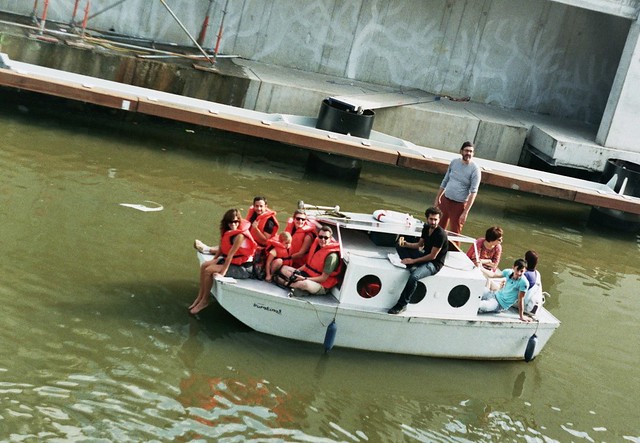
Sailing down the canal in the silence of a solar-powered boat wasn’t something to shout about, I thought, preparing for a quiet day at Festival Kanal and trusting that the ever-so-slow rhythm of the ride would inadvertently impose a state of “still-being” on our hopefully receptive passengers.
creation date: 2012-09-26 11:35:23 author: content:Sailing down the canal in the silence of a solar-powered boat wasn’t something to shout about, I thought, preparing for a quiet day at Festival Kanal and trusting that the ever-so-slow rhythm of the ride would inadvertently impose a state of “still-being” on our hopefully receptive passengers.
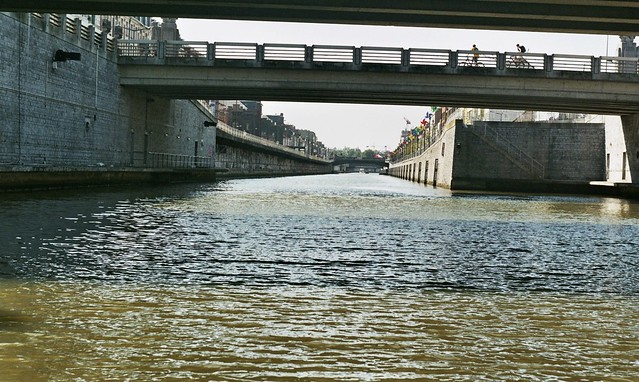

I was wrong about that. Not the state of still-being, not the effect of the slow and gentle rhythm on our passengers - all that worked out fine. What surprised me was that this meditative boat ride would become the focus of sustained yelling and shouting on all sides. Bystanders on the canal’s edge needed to impress surrounding pedestrians with catcalls directed at those quietly sitting in the boat, usurping the light and silence of the open catacomb that is the canal.
Wonderful to see that one can scream and shout invitations to 'Come and slow down! Be still!'… Wonderful that we don't have a 'Rough Guide' to urban communication. I went through a learning curve on those placid waters between the Kaai and the Porte de Ninove. We can believe all we like that slowing down will result in an introspective reverie of lost silence - but nothing was further from the truth in what I found on the waters that Sunday.
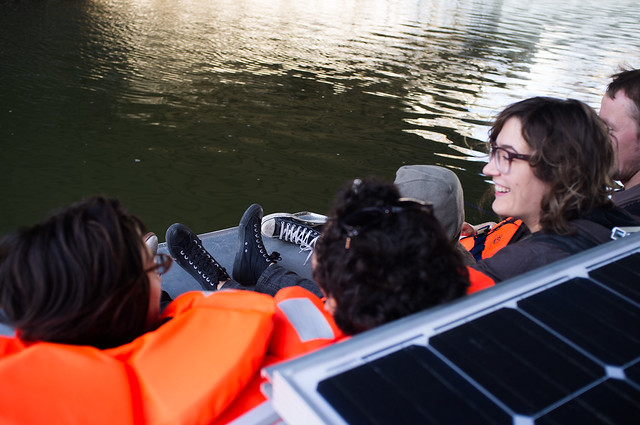
Our passengers were overwhelmed by the beauty of the city centre’s inner belly. They were ecstatic to have found places they never knew existed, and people began spontaneously relating stories. The silence was not therapeutic: it was an elixir that stimulated the rediscovery of lost images from the depths of that forgotten and sometimes stinking artery of the city.
Yet to be fair, it wasn't all yelling and catcalls; some people just sat staring at the water as if seeing the canal for the first time in their lives; sitting still and gazing at the stone walls, the towering edges of the city looming above them. The Taxi Service might have been a fantom journey, but there were no clouds or disappearing tricks, no funtoosh! and kablooiee! - it was just people sitting and doing nothing.
Buratinas did surprise and confront, unearth and flush down. A trip trough town reinvented by the sun.
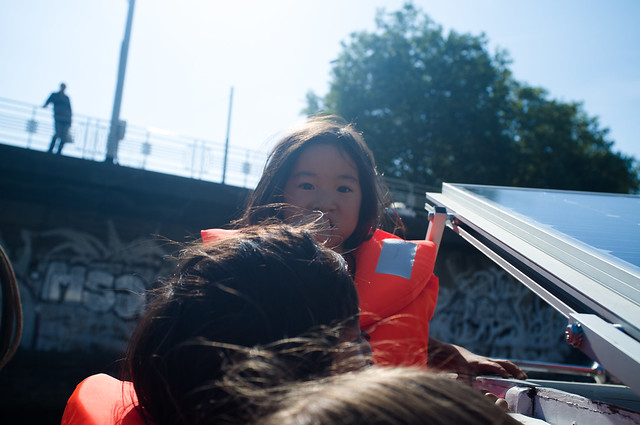
----------------------------------------------------------------------- title: CoC vessel Subak goes to Wallifornia slug: coc-vesset-subak-goes-wallifornia summary:
The Control of the Commons was a travelling waterways research project implemented on the Danube and the canals of Belgium. The vessel Subak, constructed from discarded parts with a coffee tanned junk rig sail and named after a Balinese water management practice, will be part of a new Mana Depauw and Cathy Weyders theater piece. Wallifornia investigates a future world where the lower parts of Belgium succumb to climate change and the inhabitants flee to the land of milk and honey, Wallifornia.

The Control of the Commons was a travelling waterways research project implemented on the Danube and the canals of Belgium. The vessel Subak, constructed from discarded parts with a coffee tanned junk rig sail and named after a Balinese water management practice, will be part of a new Mana Depauw and Cathy Weyders theater piece. Wallifornia investigates a future world where the lower parts of Belgium succumb to climate change and the inhabitants flee to the land of milk and honey, Wallifornia.

It's inevitable to be part of a Mottainai chain of events when you move to New York City. The spoil of fuel on oversized cars, the excess of lights when nobody is watching and the Matryoshka Russian doll concept for packing the "food to go" inside of a container, inside of another and another container. .....If you see the trash as bricks, then you are extremely rich in this city, and also you can create a huge conscience about your everyday Mottainay.
creation date: 2012-09-29 22:46:57 author: content:
Mottainai (もったいない, 勿体無い?) is a Japanese term meaning "a sense of regret concerning waste when the intrinsic value of an object or resource is not properly utilized".[1] The expression "Mottainai!" can be uttered alone as an exclamation when something useful, such as food or time, is wasted, meaning roughly "Oh, what a waste!" In addition to its primary sense of "wasteful", the word is also used to mean "impious; irreverent" or "more than one deserves".[2]
It's inevitable to be part of a Mottainai chain of events when you move to New York City. The spoil of fuel on oversized cars, the excess of lights when nobody is watching and the Matryoshka Russian doll concept for packing the "food to go" inside of a container, inside of another and another container.
Thanks, but no thanks… I don't need that plastic bag.
If you see the trash as bricks, then you are extremely rich in this city, and also you can create a huge conscience about your everyday Mottainay.
Local Project, after using for 6? years 45-10 Davis Street in Queens for art events, was able to get an adjacent space of 33 x 13 feet. This is going to be added to the original gallery.
This new white canvas had to be a flexible area which lets many different activities go on, such as: bi and tri dimensional art shows, lectures, fairs, music concerts, theater plays, parties, office and meeting, etc…
After taking all these pieces out of the blender, the result is Matryoshka modules made out of Mottainai New York rests. The industrial dispose known as wooden pallet shaped some moving tables that fit into some moving stage cubes, into the 33 x 13 space, into the 45-10 area in the 5 Pointz building.
Everything will be on wheels, so the user can transform the space with infinite possibilities in a matter of minutes.
The building process has been materialized by many Local Project historical collaborators, and the architect will move from his house to LP by a 15 miles ride in al old bicycle, refraining from fuel use in all of that period.
Pallet Project @ Local Project is the result of recycling waste, transport and old human relations..
More information:
- The project is going on at Local Project (www.localproject.org) in New York City.
The main constructors of the work are: Cristian Torres, Miguel Luciano, Piro Salinas
Project by: www.nicolasmatzner.com
Opening on October 6 with video performances curated by Gabriel Roldos. This is a "work in progress" and there will be projects ongoing.
on going performance of Maria Jose Duran
----------------------------------------------------------------------- title: Unmanned Resilients videos slug: unmanned-resilients-vids summary:
Here is a collection of videos, documenting a series of Unmanned Resilience workshops, the SINUNI residency and the mountan hike & wild food discovering that all took place on Gora Plateau in August 2012.
And we are now also adding the local TV show about our UR activities.
Here is a collection of videos, the documenting a series of Unmanned Resilience activities on Gora Plateau in August 2012.
UNMANNED RESILIENCE UAS BRAMOR TESTS on Vimeo.
RESILIENTS MOUNTAIN CLIMB / HIKE SHORT VID on Vimeo.
We are happy now to finally be able to upload the full show on Unmanned Resilience activities. The show is being played on local TV station as part od Sodobna Umetnost (Contemporary Art) TV series on rotating basis every month. Unfortunately it is all in Slovene and we were also asked to keep it password protected
But here is the pass: resilients
Sodobna Umetnost - Unmanned Resilients on Vimeo.
----------------------------------------------------------------------- title: Non Green Gardening 2012 slug: non-green-gardening-2012 summary:NON (GREEN) GARDENING or (edible) mushrooms
creation date: 2012-10-02 15:07:22 author: Monique Alvarez content:'I am... a mushroom on whom the dew of heaven drops now and then' John Ford, The Broken Heart (1633).
And who said: 'Life is too short to stuff a mushroom'???
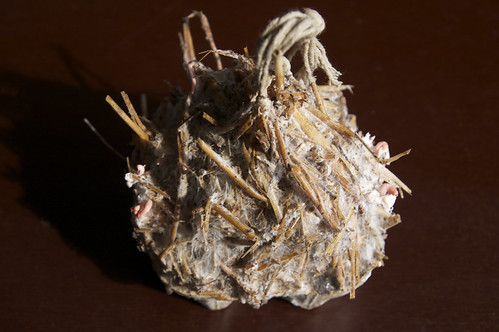
“Non-Green Gardening” is the selected project out of the Time's Up Open Call for Gardener and Machinist in Residence, applied by Natalia Borissova. The project is part of the pan-European project Resilients and Augmented Urban Gardens.
Non Green Gardening is the series of living-lab experiments with mushroom cultivation through research, curiosity and practical experience, involving some technological elements and based on bio-remediation /conversion of locally available raw organic by-products from households, gardens, farms, forests and agriculture into the brain/soul/soil-consciousness sustenance.
Throughout a time-period of six month, Natalia Borissove will be on-site at the harbourside laboratories for at least three times to follow the fungal kingdom's eternal process of turning death into life, toxins into food and unstable into sustainable. Her current interests within her presence at Time's Up are lined out as followed:
Teaming up mushrooms (mycelium) with plants (roots) into the Myco-eco-system, where plants provide oxygen to the mushrooms and mushrooms make carbon dioxide for the plants in return. They are also plant-protective (some species actively kill virus’s, nematodes, insects, etc). Which kind of greens to plant in relation to which mushrooms, where, how, types of substrates, etc. - to find out, observe during the project in co-relation.
Starting the Myco-bed culture.
Starting the Myco-log culture.
Testing some unconventional conditions and (organic) fertilizers for better fruiting/growing (giant).
Making a mini Myco-eco-system by grow mushrooms mixed with some plants in the aquarium-like container for the better observation/documentation and experimentation with light, humidity, temperature in connection to environmental sensors for mushroom-data cultivation and harvesting.
Some sterile experiments (more lab-related) such as growing of the mycelium on Agar in Petri Dishes spore-/less from newly cultivated and/or distinctive edible wild mushrooms.
Microscopic observations and documentation of the mycelium could be a very spectacular natural performance.
Testing mushroom-potential as a remediative tool.
See images of the progress and results
Follow the process on Natalia Borrisova's page
Notes recording Natalia's residences
----------------------------------------------------------------------- title: CoC - Trip 01 / Murray River - 01.02.2012 - 21.02.2012 slug: coc-trip-01-murray-river summary:Control of Commons (CoC), a project by Time's Up with a load of partners aims to undertake an artistic exploration of the relationship of people to water and the way that effects travel along watercourses, by making a series of trips along several watercourses in Europe and Australia.
creation date: 2012-10-02 15:20:09 author: Monique Alvarez content:The first journey along a river is accomplished. 7% of the river’s total in 3 weeks! For more written documentation about this trip along parts of the Murray River in Australia look up coc.timesup.org
See images of the trip on the Time's Up Flickr page
Read the travel blog on the TUBA website
----------------------------------------------------------------------- title: CoC - Trip 02 / Danube - 31.03.2012 slug: coc-trip-02-danube summary:Exploring parts of the Danube / collecting stories along the river
creation date: 2012-10-02 15:32:29 author: Monique Alvarez content:The second journey of Control of Commons (CoC), undertook an artistic exploration of the relationship of people to water and the way that effects travel along watercourses exploring a section of the Danube.
See images of this trip on the Time's Up Flickr page
Read the travel blog on the TUBA website
----------------------------------------------------------------------- title: CoC - Trip 03 / Belgium Canals - 23.05.2012 - 01.06.2012 slug: coc-trip-03-belgium-canals summary:The third trip of the CoC - Project on the Belgian Canals
creation date: 2012-10-02 15:48:42 author: Monique Alvarez content:This was our last journey within the Control of Commons. Which led us up and down rivers and canals to Brussels. We left from just inside the French border, to get the full experience of a border crossing.
More days of travelling and interviewing people living, working, relaxing along the watercourse we will sail, paddle and drift along.
Read the travel blog on the TUBA website
----------------------------------------------------------------------- title: CoC - Talk Port Adelaide slug: coc-talk-port-adelaide summary:Come and hear about the CoC journey on the Murray River
creation date: 2012-10-02 15:59:57 author: Monique Alvarez content:After 3 weeks travelling down the Murray, talking to a wide variety of people along the river, we return to Port Adelaide in order to talk about some of our experiences. This talk will outline our motivations for the project, building from our work with resilience, recycling and stories, then talk about the building, the journey and some of the many stories we have heard over this time. 6pm-8pm
----------------------------------------------------------------------- title: Sensing Resilience Workshop slug: sensing-resilience-workshop summary: creation date: 2012-10-04 11:27:11 author: Monique Alvarez content:Learning how to use the SINUNI - sensor system, sharing with the local community, developing a system for use in the Time's Up garden to trace the state of various plant beds.
See images of the workshop on the Time's Up Flickr page
----------------------------------------------------------------------- title: Im Garten / In The Garden Exhibition slug: im-garten-garden-exhibition summary:Living Spaces between desire and experiment
creation date: 2012-10-04 11:33:35 author: Monique Alvarez content:The exhibition "In the Garden - Living spaces between desire and experiment" run by the Linz-based museum Nordico took a look at Linz specific urban garden sceneries as well as it examines contemporary, international relevant gardening-architectures and current practices like Community or Guerilla Gardening.
----------------------------------------------------------------------- title: CoC - Workshop 01 slug: coc-workshop-01 summary:Build your own boat - as simple and sustainable as possible
creation date: 2012-10-04 11:40:21 author: Monique Alvarez content:Before we can start our explorations of our relationships to water and our relationships along and across watercourses we have to investigate the necessary technologies.
Within this first workshop we concentrate on the construction and restoration of vessels - built with recycled materials found around our environment in the harbour of Linz and the reassembling of existing craft which no one wants to use anymore.
----------------------------------------------------------------------- title: CoC - Workshop 02 slug: coc-workshop-02 summary:Ways to propel your boats with wind and muscle power
creation date: 2012-10-04 11:43:26 author: Monique Alvarez content:Since our last workshop we have a vessel, now we want to get around, with the carbon footprint of the wind and what we had for breakfast. This workshop investigated the possibilities for poling, sailing, rowing, paddling, pedalling, sculling, towing and drifting using a range of techniques from around the world.
----------------------------------------------------------------------- title: Kanal Labs: Triangulated slug: kanal-labs-triangulated summary: creation date: 2012-10-04 12:00:44 author: Monique Alvarez content:As a part of "Kanal Labs triangulated"; FoAM and Urbanibalism served a range of detoxifying bites, especially crafted to eliminate toxins and pollutants from the human bodily ecology.
----------------------------------------------------------------------- title: Splinterfields: Mathematickal Arts slug: splinterfields-mathematickal-arts summary:Impressions from the Mathematickal Arts workshop at FoAM in Brussels, 23-25 July 2011
creation date: 2012-10-04 12:13:30 author: Monique Alvarez content:The workshop explored the question whether combining mathematics and textile design can make both 'crafts' more resilient, and help us understand the basics behind contemporary programming.
----------------------------------------------------------------------- title: Mathematickal Arts Workshop slug: mathematickal-arts-workshop summary: creation date: 2012-10-04 12:17:05 author: Monique Alvarez content:Mathematician and machine artist Tim Boykett (Time’s Up, AT) and textile designer and educator Carole Collet (Central Saint Martins College, UK) will lead a three-day workshop bringing together the arts of mathematics, textiles and computer programming. The Mathematickal Arts workshop investigates the tangible, abstract and conceptual threads binding materials and machines in a series of practical and theoretical experiments. Participants will use knots, weaving, sorting algorithms, notation and geometry to explore unfamiliar territories of mathematics or crafts using familiar practices of artistic and technological experimentation.
“To me the simple act of tying a knot is an adventure in unlimited space. A bit of string affords the dimensional latitude that is unique among the entities … another dimension is added which provides an opportunity that is limited only by the scope of our own imagery and the length of a ropemakers coil.”
– Clifford W. Ashley, The Book of Knots
A Resilients Salon with Dougald Hine and Ben Vickers
creation date: 2012-10-04 12:23:39 author: Monique Alvarez content:Writer and collapsonomist Dougald Hine hosts a conversation about how we make a living and support each other in times of precariousness and disruption. As artist-in-transience with The Resilients Project, he is exploring the possibilities of guild-like structures of mutual aid as a strategy for resilience. Dougald will be joined by his regular co-conspirator, Ben Vickers, who has been part of the Temporary School of Thought, the Really Free School and The University Project, and is currently developing a Professional (Reality) Development Programme for arts students at Brighton University.
Resilients Salons are conversations about cultural resilience in its many forms. Every salon hosts a guest who engages participants in a discussion about a resilience-related topic, such as long-term thinking, augmented gardening or disaster drills. The atmosphere is casual to inspire participation of everyone involved, accompanied with thematic food and drinks. The salons are a part of the pan-European Resilients Project where six organisations speculate on and experiment with possible futures.
This Resilients Salon is a part of Springcamp 2012 - System Error: in times of crisis, artists take a stand. Springcamp is organised and hosted by Timelab, in collaboration with Argos, Vooruit, Beursschouwburg and FoAM.
On Leadership and Crisis: Complexity, Emergence and Relationship Mapping
creation date: 2012-10-04 12:46:58 author: Monique Alvarez content:Julian Still leads us into the heart of complex systems, illustrating his voyages as systemic practitioner and his continuing mission to explore and help strange new worlds evolve. Julian will join us for an inspiring discussion on leading and coaching organisations through crisis. Emergence, relationship mapping and constellations will be investigated and explored both theoretically and tangibly.
Julian Still is COO when the impossible is required, green entrepreneur and systemics visionary. An expert in leadership and crisis, he leads, coaches and teaches organisations and individuals facing the most difficult situations.
Just before the Salon, from 5:30 to 7:30 pm, Vali Lalioti facilitates a TryAdd with business coaches.
The event is organised in collaboration with Vali Lalioti and FoAM as part of the Resilients initiative.
----------------------------------------------------------------------- title: Buratinas slug: buratinas summary: creation date: 2012-10-04 13:04:22 author: Monique Alvarez content:Buratinas is a project and a boat run by individuals from two Brussels organizations, FoAM and Nadine.
Looking at the well-known mobility crisis in Brussels and the obvious availability of one major transportation route straight through the city, Buratinas proposes an alternative means of transportation by bringing a solar-powered taxi service to Festival Kanaal.
The Buratinas Taxi Service offers people the possibility of transportation through Brussels in an ever-so-slow duck's-eye-view sightseeing experience. Taking its time to show rather than move people around, It serves as a romantic, idiosyncratic glue between the various locations of the Festival.
During these trips an old seafarer's habit will be revived where true, imagined, old, recent and downright outrageous stories will be offered and accepted as currency for the service.
----------------------------------------------------------------------- title: Rocket Boat Day #1 slug: rocket-boat-day-1 summary:Rocketboat Day promised a blend of backyard naval architecture and rocket science.
creation date: 2012-10-04 13:18:04 author: Monique Alvarez content:
Rocketboat Day 1 is a participatory event where people build little boats, power them with rocket engines and race them to see which one gets the furthest. The inaugural event took place on a nice, calm bit of water somewhere on the Brussels to Charleroi kanal. Let's find out what happens when a C6 model rocket engine is attached to a boat made out of anything you can get your hands on. The cool breeze off the water will blow the sweet acrid smoke across your face like a lovers caress.
fo.am/rbd
Rocketboat Day is an evolution of the established tradition of Rocketcar Day. See the last one at rcd12.rocketcarday.com
CoC Boat "Subak" arrives in Brussels!
----------------------------------------------------------------------- title: Resilients Salon at Burning Ice slug: resilients-salon-burning-ice summary:FoAM hosts a conversation about human-plant interactions in gardens, labs and kitchens, with the Center for Genomic Gastronomy, Angelo Vermeulen, Time's Up, nadine on the closing evening of the Burning Ice Festival in Brussels.
creation date: 2012-10-04 13:31:17 author: Monique Alvarez content:"I propose that we should adopt the plant as the organizational model for life in the twenty-first century, just as the computer seems to be the dominant mental/social model of the late twentieth century, and the steam engine was the guiding image of the nineteenth century. This means reaching back in time to models that were successful fifteen thousand to twenty thousand years ago. When this is done it becomes possible to see plants as food, shelter, clothing, and sources of education and religion.” -Terrence McKenna
At the epicentre of culture, gardening and technology we might be able to glimpse how plants can become organisational principles for human society in the turbulent times of the 21st century. Although we have to scavenge the fringes of contemporary society, we can observe many healing effects that humans can have on their surroundings through a symbiotic collaboration with plants. However, on a holistic level, we still don’t know how to overhaul wasteful human behaviours en masse. How do we encourage a more resilient culture, so that humans and non-humans can continue living, preferably together? How do we stimulate a fertile entanglement of culture, gardening and technology that can give the rise to diverse communities of practice? Communities capable of forging symbiotic relationships between post-industrial human societies and the rest of the earth. Composting bitterness to grow beauty.
To explore possible answers to such questions, FoAM hosts a Resilients Salon on Vegetal Culture, in conversation with Center for Genomic Gastronomy, Angelo Vermeulen, Time's Up, nadine and other participants of Burning Ice. The atmosphere is casual to inspire participation of everyone involved, accompanied with thematic food and drinks. Inspired by the title of the festival – We The Gardeners – FoAM invites all guests to bring one or more tomatoes from their garden, windowsill, or a neighbourhood green-grocer, as an entrance-fee. During the salon the tomatoes will be cooked into a soup and shared with everyone, as a closing feast of Burning Ice 2012.
NonGreenGardening results and anecdotes
In 2011 we made an open call for finding interesting concepts for our Augmented Urban Garden. It was Natalia Borissova's Non-Green-Gardening project which was the most appealing one. Within the last months she was regularly onsite - developing and improving her concept of a Non-Green Garden at the Time's Up Labs.
Together with Natalia and Dismas Leonard we are still maintaining a hybrid - green / nongreen-garden. Pros- and Cons of such a project in urban areas will be discussed during this event between 2 and 5 PM
There will be a presentation of the Augmented Urban garden and its background of the Resilients project, some anecdotes regarding our battles with slugs and other less welcome guests in our garden. We will be serving some delicious dishes from the last harvest of our garden fruit and then send the beds off to their winter dormancy.
http://timesup.org/NonGreenGardening
http://www.flickr.com/photos/times_up/sets/72157629601830295/
----------------------------------------------------------------------- title: Resilients Naikan slug: resilients-naikan summary: creation date: 2012-11-22 14:03:13 author: Maja Kuzmanovic content:“Naikan is a method of intensive self-reflection that can lead to more inner freedom and joy. A week of Naikan allows you to examine your view on life by observing your inner world, calmly, in a completely safe space. The silence and withdrawal enable a deep, meditative and emotionally intense experience, by which self-perception can be re-calibrated and a fresh view on our life story can take place.”
– From Christina Stadlbauer’s page: http://shiatsubrussel.be/index.php?/english/naikan---looking-inside/
We will use Naikan at FoAM in the Future Preparedness case study of the Resilients project. Our hypothesis is that individual introspection, when done as part of a collective in their common workspace, could greatly improve the group’s collaboration and communication processes, making them more resilient overall. We work with Helga Hartl as the guide during the retreat, and Alkan Chipperfield will provide some anthropological contextualisation post-retreat. Ten Naikan participants come from FoAM Brussels and Amsterdam, as well as our wider network of collaborators.
----------------------------------------------------------------------- title: FoAM interview in MCD #65 slug: foam-interview-mcd-65 summary: creation date: 2012-11-22 14:12:10 author: Monique Alvarez content:An interview with Maja and Nik is featured in the recent issue of MCD – "L’INTERNET VOIT VERT / THE CULTURE OF GREEN TECH" – in which they discuss groworld, resilience and facing uncertainty.
http://www.digitalmcd.com/2011/12/05/mcd65-linternet-voit-vert-the-culture-of-green-tech
----------------------------------------------------------------------- title: The Guild and the Garret slug: guild-and-garret summary: creation date: 2012-11-22 14:24:37 author: Nik Gaffney content:The recording of the inspiring conversation between Dougald Hine and Ben Vickers, "The Guild and the Garret" at Timelab last weekend is now available from the internet archive.
http://archive.org/details/TheGuildAndTheGarret
----------------------------------------------------------------------- title: Notes from the Sensing Resilience workshop slug: notes-sensing-resilience-workshop summary: creation date: 2012-11-22 14:55:20 author: Monique Alvarez content:Notes from the workshop can be found here:
http://libarynth.org/resilients/sinuni_workshop#workshop_noteslive
----------------------------------------------------------------------- title: Augumented urban gardening - a snap shot slug: augumented-urban-gardening-snap-shot-dismas-sekibaha summary:One thing I knew for sure was the challenges of writing about the experiences of breeding mushrooms alongside green edible plants in the augmented urban gardening structure. I knew it from the beginning it wont be easy to write about it but it was great that I didn't have to worry about breeding them, neither taking the chance of caring for them. It was the likes of tomatoes, salads, potatoes, paprikas, beans, cucumbers, pumpkins, oregano, rosemary, thyme, mints and so many other aperitive plants that kept me working on those hanging beds since i knew at the end of the day they are all going to be eaten, and of course I will be part of the feasting activities.
creation date: 2012-11-22 15:31:31 author: Monique Alvarez content:
A part of the Unmanned Resilence Team (Marko, Matthew, Kenny and Hafiz) are continuing to develop SINUNI sensor network and flying the Bramor UAS on orto-photo missions. This time they are way up north in the Arctic Circle, occupying the Kilpisjärvi Biological Station, situated in the mountain birch forest zone near the 70th parallel of northern latitude (69°03′N; 20°50′E) in the northwesterenmost part of Finland until the end of November.
Apparently aurora borealis has already been detected.
For more notes and blogs entries posted by our API / Resilients team in residency in Kilpisjaervi, FI, check out this link
----------------------------------------------------------------------- title: picking season slug: picking-season summary:
: I was almost sure that the NGG picking season is over and i was about to take a winter break from mushrooms for a while
creation date: 2012-11-30 10:01:26 author: content:
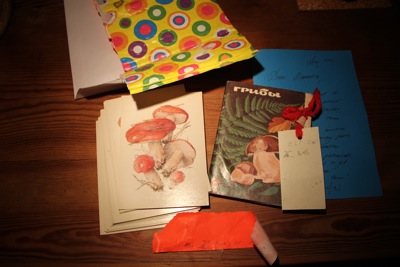
I was sure that the NGG picking season is over and thought of taking a winter break from mushrooms. It has been raining quite a bit since last days here in B and now the mushrooms are up again, in fact in my post box. At the first look - an innocent little parcel colorfully packed with the familiar to me return address of TU-Land. Hm, did i forget something they do not want to keep around or do they want to poison me with some kind of newly appeared mushroom? "Both guesses are wrong;) surprise. xtn". Well-well, at last one of my guesses was close to the surprise's content: Of course it's about mushrooms! Both poisonous and non. 32 types in total. Painted by A. Shpilenko. Printed out on coated paper. As a postcards. Moscow. 1976. The original price: 1 Ruble, 20 Kopeek. Sold out for 3,- Euro. Bought by TU. At the auction/Foam. Signed by 1,2,3,4... resilients --Bwhoo, just like a fairy tale with a happy end..!! (Thank you guys. Ah, of course i like..................................................................You;) 29.11.12 ñ
----------------------------------------------------------------------- title: NonGreenGardening Series slug: nongreengardening-series summary:"NON GREEN GARDENING (NGG) - The ongoing series of living-lab experiments with mushrooms through contemplation and magic. It means to observe and learn from fungal dynamic behavior to continuously explore, adapt to the environment, recycle pathways and always invent on principles that can not be found/fit in any conceptual framework."
creation date: 2012-12-04 13:48:42 author: Monique Alvarez content:"NON GREEN GARDENING (NGG) - The ongoing series of living-lab experiments
with mushrooms through contemplation and magic. It means to observe and
learn from fungal dynamic behavior to continuously explore, adapt to the
environment, recycle pathways and always invent on principles that can not
be found/fit in any conceptual framework."
Text by Natalia Borissova
http://aa-vv.org/node/146
http://aa-vv.org/node/145
The prehearsal of the Resilients, starting at 12:12:12 on the 12-12-12, the Anti-Apocalypse Day. It is an exercise for the members of the Resilients Guild, to pre-enact a possible future scenario named "The Flotilla"
“In this possible future, The Resilients guild with members and cells around the world decides to lift its anchor. There is no security of funding or the status of artists as independent operators. The arts have become radically bureaucratised, reaching Kafka-esque proportions. The cost of living is prohibitively expensive. Individual artistic careers are impossible to attain, except for the select few artists who serve the tastes of the rich and famous. Universities have become machines for producing papers, but education and research happen elsewhere – in alternative, ad-hoc spaces, in collectives of people eager to learn. Technologists are either brainwashed into serving the capitalist machinery, or drop out and become sought after hackers, feeding technological resistance movements. Environmentalists are disillusioned by the global apathy and are either growing more radical, or attempt to infiltrate the political and economic systems, just to be slowly swallowed and transformed by them. Small groups of people retreat into a bucolic mirage of intentional communities and village life, where permaculture and new age intermingle into a somewhat escapist mixture.
The members of the Resilients became tired of fighting the windmills and see that the only way forward is to fully commit themselves to the collective vision they've been cultivating over the years and begin growing their own world: The flotilla, a distributed, semi-nomadic troupe sharing a collective vision of the world and their place in it.”
A 24 hour period in the Flotilla will be experienced by those participating, enacting the working life in this possible future. A debriefing session attempts to unravel the responses to this lifestyle, to look at the ways that the experiences gathered there can echo into the present to inform our ongoing activities.
http://lib.fo.am/resilients/the_flotilla
----------------------------------------------------------------------- title: Dougald Hine, Journeyman: transiency and cultural resilience slug: dougald-hine-journeyman-interview-transiency-and-cultural-resilience summary:Dougald started a transiency at foam in July 2012, exploring the role of the Journeyman and what this could mean to the Resilients Guild. His travels took him to interesting places and conversations across Europe, reflecting on cultural resilience, travelling and the absurdity of foresight. This interview was taken while reflecting in Rab, Croatia in July 2012 in the middle of his transiency.
creation date: 2013-01-04 14:48:50 author: shelbatra jashari content:"I set off from Stockholm on the evening of 8 July, 2012. For the first two weeks, I travelled fast: visiting people and projects that had been on my mind, recording the traces of the journey and the chance encounters to which it led. After that, I slowed down, spending time with groups of friends and collaborators, first in Croatia and later in Denmark. All of these journeys were made by rail and by ferry. Over the later part of the summer, I began to write up some of the longer reflections from the journey, picking up further threads of conversation along the way. As of October, I am gradually completing the map of my travels with notes from the journey."
– Dougald Hine
More information: http://rhapsodi.se/resilients/?page_id=41
Interview with Dougald about the different aspects of his work and more particularly his view on cultural resilience and the role of "Journeyman" in our times.
The transcript of the interview with Dougold can be found here: http://lib.fo.am/resilients/dougald_hine_interview
----------------------------------------------------------------------- title: Boucalais: a mobile studio slug: boucalais-mobile-studio summary:Boucalais is a mobile studio: Boucalais is a walking trail from Boulogne-sur-Mer to Dunkirk via Calais which Various Artists has travelled several times a year for seven years. The trail is a studio where a number of VA revise their work or where new work is created.
creation date: 2013-01-04 17:56:22 author: shelbatra jashari content:Boucalais is a mobile studio: Boucalais is a walking trail from Boulogne-sur-Mer to Dunkirk via Calais which Various Artists has travelled several times a year for seven years. The trail is a studio where a number of VA revise their work or where new work is created. The creations are poetic expressions on the road, as it were, and which – given the mobile context – are necessarily on a small scale or ‘light’. The Boucalais project pays homage to the artist-collector who, in the course of his journey, assembles a collection of objects and observations, which will – sometimes literally – be dragged back to his studio as so many installations and ‘objets trouvés’. At the same time, the work is often intangible and only lives on in documentary form. Since, in the case of VA, the journey is largely equivalent to the studio, this collection of objects, routines and documentation is used as raw material/ oxygen/ basic component for (artistic) creation ‘en route’.
Boucalais is a format or work method: Boucalais started in 2005 as a fixed walking trail, and grew over the years to a format, a state of mind inviting the VA to develop, revise and/or renew their work methods and preconceptions. The walking format challenges the artist’s production mechanisms, and makes room for another interpretation of what constitutes artistic work. At times, the work is no more than a distinctive mark or a trace on the trail. The VA are thus continuously led to adapt their idea of creation and constantly develop different work methods.
Boucalais is a performance on the road: Boucalais can also be seen as a real-time performance, a performed creative process out of which work emerges that is shown either en route or at predefined locations along the trail: interventions on the roadside and routines in hotel rooms are subtle installations and markings executed by VA, but without an audience consciously looking on. These are but small interventions in the landscape, fragments of songs by a singer-songwriter, anonymous witnesses who return every day for this temporary artist-walker.
For more information:
In Words which Matter to People, Dougald Hine questions the concept of “resilience” itself – not through academic debate, but by talking to people on the streets of Helsinki about the Finnish word sisu. Comparing their visceral and culturally grounded use of this concept with the distant, etiolated notion of “resilience” as it is deployed in political, environmental and scientific discourse, he finds that the meaning we make or find in the world – embodied in such notions as sisu – is deeply bound up with our capacity to endure in turbulent times. Read more about Dougald’s travels as journeyman and artist in transience in his wide-ranging conversation with Shelbatra Jashari for the Resilients project.
creation date: 2013-02-17 02:50:47 author: Nik Gaffney content:In Words which Matter to People, Dougald Hine questions the concept of “resilience” itself – not through academic debate, but by talking to people on the streets of Helsinki about the Finnish word sisu. Comparing their visceral and culturally grounded use of this concept with the distant, etiolated notion of “resilience” as it is deployed in political, environmental and scientific discourse, he finds that the meaning we make or find in the world – embodied in such notions as sisu – is deeply bound up with our capacity to endure in turbulent times. Read more about Dougald’s travels as journeyman and artist in transience in his wide-ranging conversation with Shelbatra Jashari for the Resilients project.
Read more at Resilients in Review
----------------------------------------------------------------------- title: Boating, Control of the Commons and Aristology slug: boating-control-commons-and-aristology summary:Tim Boykett, Pippa Buchannan and a motley crew of enthusiastic DIY sailors embarked on an exploration of water rights and “luminous green” sailing in Control of the Commons. In Resilient Boating, Tim writes of sustainability, graceful decay, and the balance of effort versus utility in the realm of boat building and sailing, while Pippa recounts how a confessed food lover embraces the challenge of improvised gourmet cooking for several people on a tiny boat in The Resilient Aristologist. Each of their boating adventures is narrated in the Murray River Journey, the Danube Journey, and the Belgian Canals – as are the details of how they went about constructing the two vessels they sailed, the Subak1 and Subak2. Also check out some notes towards a manifesto of a DIY pirate.
creation date: 2013-02-17 02:54:59 author: Nik Gaffney content:Tim Boykett, Pippa Buchannan and a motley crew of enthusiastic DIY sailors embarked on an exploration of water rights and “luminous green” sailing in Control of the Commons. In Resilient Boating, Tim writes of sustainability, graceful decay, and the balance of effort versus utility in the realm of boat building and sailing, while Pippa recounts how a confessed food lover embraces the challenge of improvised gourmet cooking for several people on a tiny boat in The Resilient Aristologist. Each of their boating adventures is narrated in the Murray River Journey, the Danube Journey, and the Belgian Canals – as are the details of how they went about constructing the two vessels they sailed, the Subak1 and Subak2. Also check out some notes towards a manifesto of a DIY pirate.
Read more at Resilients in Review
----------------------------------------------------------------------- title: Mushrooms and urban gardening slug: mushrooms-and-urban-gardening summary:Natalia Borissova explored augmented urban gardening through a series of living lab experiments with “non-green” mushrooms, finding in fungi an infinite source of inspiration for recycling and adaptation to changing environmental conditions. Her practical explorations in mushroom growing are documented in The Non Green (R)evolution, while Go Ask a Mushroom: musings on Afterculture advocates fungi and their mycelial roots as a source of continued inspiration for a resilient “life after culture.” At the same time, Dismas Leonard Sekibaha narrates his experiences at Time’s Up as “gardener in residence” – of both the green and non-green variety – in My Summer in an Urban Garden.
creation date: 2013-02-17 02:55:56 author: Nik Gaffney content:Natalia Borissova explored augmented urban gardening through a series of living lab experiments with “non-green” mushrooms, finding in fungi an infinite source of inspiration for recycling and adaptation to changing environmental conditions. Her practical explorations in mushroom growing are documented in The Non Green (R)evolution, while Go Ask a Mushroom: musings on Afterculture advocates fungi and their mycelial roots as a source of continued inspiration for a resilient “life after culture.” At the same time, Dismas Leonard Sekibaha narrates his experiences at Time’s Up as “gardener in residence” – of both the green and non-green variety – in My Summer in an Urban Garden.
Read more at Resilients in Review
----------------------------------------------------------------------- title: Leaks, Alchemy and the silient side of things slug: leaks-alchemy-and-silient-side-things summary:Edible Alchemy by Carole Collet and Bartaku discusses resilience and adaptation in relation to the properties of two intriguing plants – flax and Aronia – and how these were used in Temporary photoElectric Digestopians (TpED), a series of co-creation worklabs, and the Edible Alchemy Aperolab. Resilience Thinking DIY was an exercise held at Central Saint Martin's College and summarised here to encourage readers to practice resilient thinking in design. A Leaky Loop by Bartaku narrates the kind of intimate and bizarre experience you can expect as a TpED creator and tester, while Silients is a fragmentary meditation on a peculiar variation of “resilients.”
creation date: 2013-02-17 02:56:48 author: Nik Gaffney content:Edible Alchemy by Carole Collet and Bartaku discusses resilience and adaptation in relation to the properties of two intriguing plants – flax and Aronia – and how these were used in Temporary photoElectric Digestopians (TpED), a series of co-creation worklabs, and the Edible Alchemy Aperolab. Resilience Thinking DIY was an exercise held at Central Saint Martin's College and summarised here to encourage readers to practice resilient thinking in design. A Leaky Loop by Bartaku narrates the kind of intimate and bizarre experience you can expect as a TpED creator and tester, while Silients is a fragmentary meditation on a peculiar variation of “resilients.”
Read more at Resilients in Review
----------------------------------------------------------------------- title: The Pollinators slug: pollinators summary:
In The Pollinators, nadine review the meaning and implications of reviving modes of cultural travel where the journey is the destination, as an antidote both for tourism and the utilitarian obsession with getting from A to B in the shortest time and space.
creation date: 2013-02-17 02:57:35 author: Nik Gaffney content:
In The Pollinators, nadine review the meaning and implications of reviving modes of cultural travel where the journey is the destination, as an antidote both for tourism and the utilitarian obsession with getting from A to B in the shortest time and space.
----------------------------------------------------------------------- title: If you can't pay for a loaf... slug: if-you-cant-pay-loaf summary:In connection with the Unmanned Resilience case study, Uroš Veber interviewed Helena Krapež, the owner of an excursion farm on the Gora plateau in western Slovenia. If you can’t pay for a loaf, go bake your own is a fascinating ethnographic glimpse into the state of farming in this region, and by extension, the changes and upheavals taking place in wider society – not to mention the resourcefulness of one woman in challenging circumstances.
creation date: 2013-02-17 02:58:49 author: Nik Gaffney content:In connection with the Unmanned Resilience case study, Uroš Veber interviewed Helena Krapež, the owner of an excursion farm on the Gora plateau in western Slovenia. If you can’t pay for a loaf, go bake your own is a fascinating ethnographic glimpse into the state of farming in this region, and by extension, the changes and upheavals taking place in wider society – not to mention the resourcefulness of one woman in challenging circumstances.
Read more at Resilients in Review
----------------------------------------------------------------------- title: From Pan to Panarchy slug: pan-panarchy summary:
Exploring methods of prototyping possible futures, Anna Maria Orru and David Relan discuss their scenario building toolkit in Composing a Scenario Symphony. This approach draws on a combination of Lance Gunderson and C. S. Holling’s panarchy systems model outlined in From Pan To Panarchy, and the idea of The Temporal Model in Future Scenario Building.
creation date: 2013-02-17 02:59:53 author: Nik Gaffney content:
Exploring methods of prototyping possible futures, Anna Maria Orru and David Relan discuss their scenario building toolkit in Composing a Scenario Symphony. This approach draws on a combination of Lance Gunderson and C. S. Holling’s panarchy systems model outlined in From Pan To Panarchy, and the idea of The Temporal Model in Future Scenario Building.
Read more at Resilients in Review
----------------------------------------------------------------------- title: Resilients online slug: resilients-online summary:We are pleased to announce the compilation of the Resilients online publication, representing the collected reflections and working notes gleaned from two years' prolific intentional voyages, experimental situations and real-life labs exploring creative resilient practices. Beautifully illustrated with specially-commissioned imagery from Strangehalos, we present this rich body of material as both a finished chronicle of our endeavours and as a plentiful archive of working ideas and notes that can be built on and modified by anyone interested in pursuing it further.
creation date: 2013-03-29 00:55:42 author: Alkan Chipperfield content:We are pleased to announce the compilation of the Resilients online publication, representing the collected reflections and working notes gleaned from two years' prolific intentional voyages, experimental situations and real-life labs exploring creative resilient practices. Beautifully illustrated with specially-commissioned imagery from Strangehalos, we present this rich body of material as both a finished chronicle of our endeavours and as a plentiful archive of working ideas and notes that can be built on and modified by anyone interested in pursuing it further.
In this way resilients.net can be approached from several angles: skim through the topics that interest you, peruse it as a reader, or drill deeper into the unruly compost of notes, quotes, and further reading to get at the raw matériel for future fabulations. We invite you in whatever way that suits to explore, be inspired by and build on the work presented here – which we believe will surely only become more relevant as this brave new century unfolds.
----------------------------------------------------------------------- title: Blog archive slug: blog-archive summary:The archive of previous posts can be found at http://libarynth.org/resilients/blog/archive
creation date: 2013-04-02 11:09:58 author: Nik Gaffney content:The archive of previous posts can be found at http://libarynth.org/resilients/blog/archive
----------------------------------------------------------------------- title: Residency Family of Creatieves - Ceci est un magasin de vêtements slug: residency-family-creatieves-ceci-est-un-magasin-de-vetements summary: creation date: 2013-04-11 12:33:36 author: Loes Jacobs content:Five people with different backgrounds (visual arts, fashion, architecture and anthropology) were 'running' a boutique together. It was a shop with no clothes on offer, a paradoxical shop where words, objects and people came together. Ceci set un magasin de vêtetements was a shop residency project by Sara ten Westenend, Maaike Gottschal, Miriam Rohde, Annelies Kuypers and Isabelle Makay who used the contradictory set-up of the boutique without clothes as a place in fluctuation where text, objects (clothes), people and space could meet. The aim of their residency was to get an insight in practical aspects of dealing with objects or material as processes. Therefore they invited different people during their residency who are integrating a specific approach to objects and/or material in their work.
----------------------------------------------------------------------- title: N°19 residency Family of Creatives slug: n19-residency-family-creatives summary:After the tribe trip Pollinators Performing Pictures had an in situ residency in Rab, Croatia, the arrival point of the bike journey. The residency was organised there to process the vast material collected during the trip. Performing Picture worked on photo material, and mapping the chapels on the straight line the journeyers followed.
creation date: 2013-04-25 15:18:25 author: Robert Brečević content:The end of the Pollinators journey with the public event in Rab where the participants shared their experiences of the trip and showed the rough material coming from the mobile process, was also the beginning of the Family of Creatives residency by Performing Pictures. Not only Geska and Robert Brecevic, but also Cesar Brecevic, the 13 year old son of Robert who had biked along the whole line were part of this residency. As part of the residency, further chapels were designed and placed on the island. The material was used for a artist photo-book essay (1 copy) and for the online map project by artist Pacome Beru, and the exhibition UnTied Notions. (Please note that this exhibition also encompassed works from another EU-project, the EITC 2011-7480. No costs for the exhibition has been charged to the Resilients project).
----------------------------------------------------------------------- title: DIY-kit for roadside chapels slug: diy-kit-roadside-chapels summary:These are the recallings by Patrik Qvist, creator of the IKEA-style roadside solar-powered chapels left as beacons of light for fellow travellers by his friend Robert Brečević.
creation date: 2013-04-25 15:34:44 author: Robert Brečević content:"It was somewhat sad to see R take off with a sackload of roadside chapels– I had very much wanted to partake in the journey, an adventure that would take him and his fellow travelers from suburban Stockholm down through an increasingly devout Europe. Or that it was how I imagined the lands south of here; a landscape devout in terms of number of people actively pursuing a faith within the framework of organized religion. I was curious to see how the chapels would be received along the way and to know to to what extent a crude miniature chapel could inspire to a moment of contemplation along different kinds of roads in this imagined Europe.
The chapels traveled in bits and pieces; a DIY-kit that required little else than a few nails and a hammer for assembly. The image within was another matter. R brought a beautifully cast St Cristobal from Mexico made of resina, rock hard and with great detail. I spent a few nights trying to make a silicone mold from the figure which then would be used on the journey– my idea was that the figure would be cast the night before erecting the chapel, after the bikes had been dismounted and camp had been secured for the night, thus providing a night-long curing of the figure. It did not quite work out– I was lacking in experience with the material, and had already used up most of my provisions of silicone in a vain attempt to make a huge mold for the entire chapel (“no problem, Robert, you can pick up concrete anywhere along the way, all you´ll need is some water and a trowel”).
In the end, the chapel was made out of wood, and the faulty silicone mold for St Cristobal only held up for a few figures. Further down the road, the chapels became homes to icons that bore closer resemblance to the patron saint of travelers; icons that were assembled en route and thus spoke both of and for the landscapes transversed.
Whatever sadness I may have felt at the departure soon gave way to a sense of joy at receiving reports from the trip. The chapels dotted the landscape and tied together nation-states, cultures, zones of languages and monetary systems in a rough squiggle from north to south-east. My small part of making this happen started out as something rather mundane: a few night spent with sketches, silicone and plaster. Into other hands, through other lands the chapels have transcended way beyond whatever my intentions may have been for them; I imagine a strike of lightning in a muddy field; the intent curiosity of a woodpecker and the careful token of dried flowers befalling unto the chapels as we speak.
-----------------------------------------------------------------------